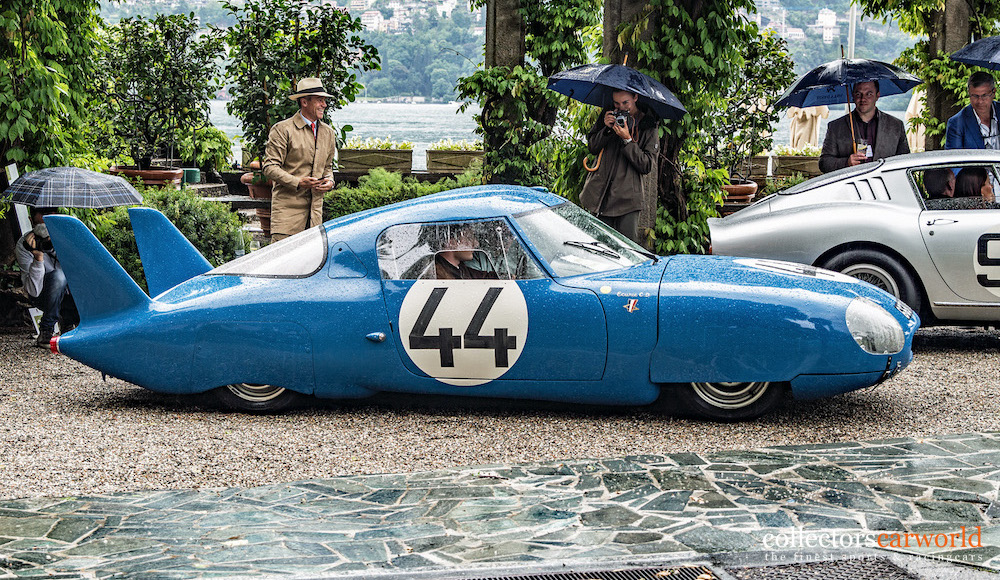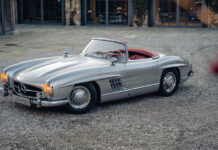Longtime partners Charles Deutsch and Rene Bonnet ended their association in 1961. Up to that point the two talented French engineers had been responsible for the Panhard competition cars for many years under the DB moniker. While Bonnet switched to support Renault’s efforts, it was Deutsch who continued to offer his services to Panhard. The first machine developed by him was the CD Panhard Dyna, which raced at Le Mans in 1962 and soon after entered production.
Again using Panhard underpinnings, Deutsch then developed a pair of purpose-built racers for the 1964 edition of the 24 Hours of Le Mans. As the largest Panhard engine available displaced a mere 848 cc, Deutsch could obviously not create a machine capable of an outright win. Instead, he set his sights on a class win and even more importantly, the Index of Performance, which was awarded to the most efficient car. Key to the competitiveness of the 1964 CD Panhard was the bespoke slippery body, which had more sophisticated aerodynamics than any other car on the grid that year.
The overall lines of the new LM64 were clearly a development of the production-based CD Panhard, which in itself was a development of earlier DB competition cars. A significant difference were the covered headlights and the elongated tail, both intended to keep drag at a minimum, which was essential on the long straights at Le Mans. To ensure the car was nevertheless stable at speed, two tall fins were mounted on either side of the tail. The car was also fitted with a complete underbody, which helped reduce drag and courtesy of its wing shape also generated down force, through what would later be known as ground effect. The CD Panhard’s drag coefficient, or Cx, was a never equalled 0.12.

Find out more on ultimatecarpage.com
The very slippery fibreglass body was mounted on an uprated CD Panhard chassis. This straightforward design consisted of a central backbone chassis with a front subframe that housed the engine and gearbox. The air-cooled flat twin engine was mounted ahead of the front wheels, which were driven through a ZF five-speed gearbox. To eke a little more performance out of the diminutive engine, a supercharger was fitted. The single transverse leaf spring used on the front suspension was replaced by coil springs. Tipping the scales at just 560 kg, the CD Panhard LM64 could make do with in-board mounted disc brakes at the front and drums at the rear.
A single LM64 was entered in the official Le Mans test where Alain Bertault clocked the 33rd fastest time. An entry was lodged for the Nürburgring 1000 km but the car did not appear. Both cars were ready in time for the 24 Hours of Le Mans and entered for André Guilhaudin and Bertault, and Guy Verrier and Pierre Lelong. Despite the modest engine used, the slippery machines were clocked at a remarkable 221 km/h down the long Mulsanne straight. Sadly, the race ended early for both cars, due to an engine and gearbox failure respectively.
Following the disappointing outing at Le Mans, the two CD Panhard LM64s were not raced again. Deutsch continued his work, and in 1966 created an all new mid-engined sports racer. Later in the decade, Porsche called in his expertise to create the long tail and low drag versions of the 917. Well ahead of its time, the LM64 ultimately did not live up to its potential. Both cars do still exist and on the 40th anniversary of their sole race outing, in 2004, they were reunited and raced in the Le Mans Classic.
 About our photographer Rainer Selzer
About our photographer Rainer Selzer
Rainer Selzer is always ready for a big shot and is focused on historic motorsport.
He is working with us for over three years and visits motorsport events, classic car meetings or car museums. Follow him on instagram @rs65photos or visit his homepage www.rs65photos.com for more!
Report by Wouter Melissen / ultimatecarpage.com
Photos by Rainer Selzer / collectorscarworld.com and rs65photos.com










